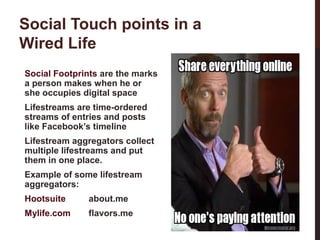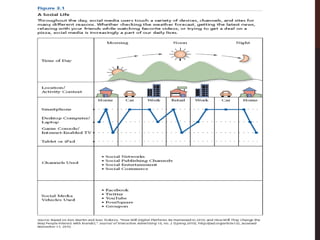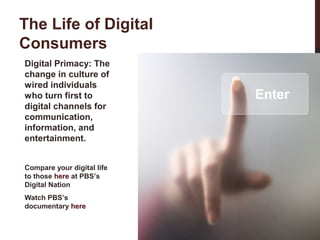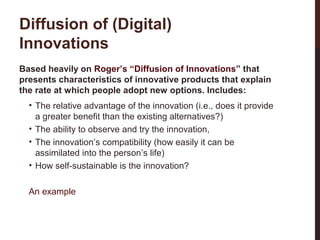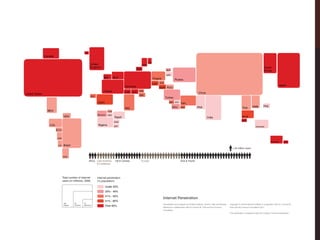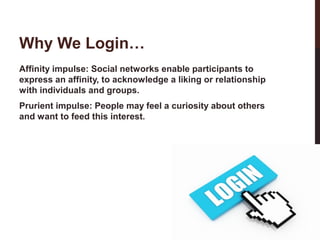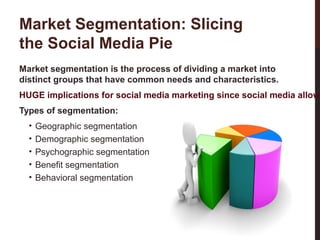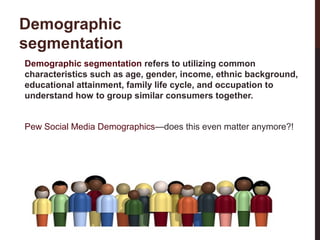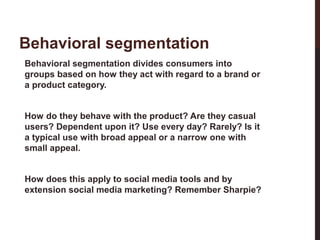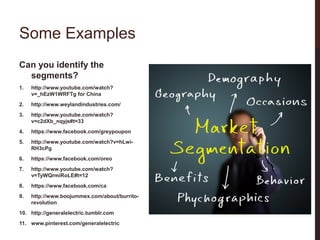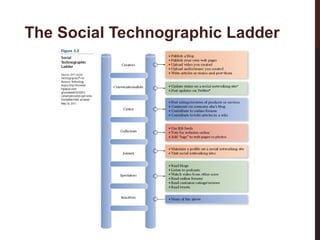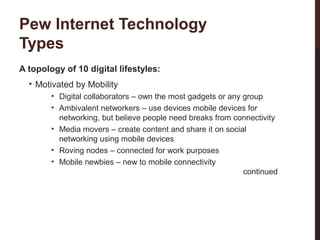MKT 380 Week 3
- 1. MKT 380 Intr oduction to social media mar keting Week 3
- 2. Chapter Objectives 2-3 How are our lives reflected online? In what ways are individuals involved in the four zones of social media? How and why does digital culture play a role in consumer behavior? Why are consumers drawn to social media activities? Which bases of segmentation are relevant to target wired consumers in a social media context? What are the most important segments of social media consumers? What do they tell us about targeting users of the social Web?
- 3. Social Touch points in a Wired Life Social Footprints are the marks a person makes when he or she occupies digital space Lifestreams are time-ordered streams of entries and posts like Facebook’s timeline Lifestream aggregators collect multiple lifestreams and put them in one place. Example of some lifestream aggregators: about.me Mylife.com flavors.me 3-3 Hootsuite
- 5. The Life of Digital Consumers Digital Primacy: The change in culture of wired individuals who turn first to digital channels for communication, information, and entertainment. Compare your digital life to those here at PBS’s Digital Nation Watch PBS’s documentary here
- 6. Diffusion of (Digital) Innovations Based heavily on Roger’s “Diffusion of Innovations” that presents characteristics of innovative products that explain the rate at which people adopt new options. Includes: • The relative advantage of the innovation (i.e., does it provide a greater benefit than the existing alternatives?) • The ability to observe and try the innovation, • The innovation’s compatibility (how easily it can be assimilated into the person’s life) • How self-sustainable is the innovation? 6-3 An example
- 7. A Wired World The measure of the percentage of a population with Internet access is known as the Penetration Rate. World Penetration Rates: • • • • Asia – 19.4% Europe – 52.0% Australia – 60.0% North America – 74.0%
- 10. Why We Login… Affinity impulse: Social networks enable participants to express an affinity, to acknowledge a liking or relationship with individuals and groups. 10-3 Prurient impulse: People may feel a curiosity about others and want to feed this interest.
- 11. Why We Login… Contact comfort and immediacy impulse: People have a natural drive to feel a sense of psychological closeness to others. Altruistic impulse: Some participate in social media as a way to do something good. 11-3 Validation impulse: Social media focuses intently on the individual.
- 12. What We Do Online? Activity Percent of Internet Users 94 Use a search engine to find information 87 Look for information online about a service or product you are thinking of buying 78 Get news 75 Go online just for fun or to pass the time 72 Buy a product 72 Watch a video on a video sharing site such as YouTube 66 Use an online social networking site such as Facebook 61 12-3 Send or read email
- 15. Generations online: A closer Look Much is made of the difference between digital immigrants and digital n Closer look at digital natives Closer look at digital immigrants And what about those left behind? Digital refugees?
- 16. Market Segmentation: Slicing the Social Media Pie Market segmentation is the process of dividing a market into distinct groups that have common needs and characteristics. HUGE implications for social media marketing since social media allow Types of segmentation: Geographic segmentation Demographic segmentation Psychographic segmentation Benefit segmentation Behavioral segmentation 16-3 • • • • •
- 17. Geographic segmentation Geographic segmentation refers to segmenting markets by region, country, market size, market density, or climate. Unimportant to social media? Think again! Location base social media is thriving driven by the need to geographically connect with potential customers 17-3 Brands can target at the local level with tools like Foursquare.
- 18. Demographic segmentation Demographic segmentation refers to utilizing common characteristics such as age, gender, income, ethnic background, educational attainment, family life cycle, and occupation to understand how to group similar consumers together. 18-3 Pew Social Media Demographics—does this even matter anymore?!
- 19. Psychographic segmentation Psychographic segmentation approaches slice up the market based on personality, motives, lifestyles, and attitudes and opinions. 19-3 Subaru has found this to be a powerful way to connect with customers…
- 20. Benefit segmentation Benefit segmentation groups individuals in the marketing universe according to their notion of value. What makes the product useful or important to them? 20-3 Extremely relevant to social media.
- 21. Behavioral segmentation Behavioral segmentation divides consumers into groups based on how they act with regard to a brand or a product category. How do they behave with the product? Are they casual users? Dependent upon it? Use every day? Rarely? Is it a typical use with broad appeal or a narrow one with small appeal. 21-3 How does this apply to social media tools and by extension social media marketing? Remember Sharpie?
- 22. Some Examples Can you identify the segments? 1. http://www.youtube.com/watch? v=_hEzW1WRFTg for China 2. http://www.weylandindustries.com/ 3. http://www.youtube.com/watch? v=c2dXb_nqyjs#t=33 4. https://www.facebook.com/greypoupon 5. http://www.youtube.com/watch?v=hLwiRH3cPg 6. https://www.facebook.com/oreo 7. http://www.youtube.com/watch? v=TyWQrmiRoLE#t=12 8. https://www.facebook.com/ca 9. http://www.boojummex.com/about/burritorevolution 10. http://generalelectric.tumblr.com 11. www.pinterest.com/generalelectric
- 23. Social Media Segments Different typologies of digital consumers: •Social Technographics from Groundswell •Pew Internet Technology Types •Anderson Analytics: Users and Nonusers 23-3 •These categories help you understand and strategically engage customers who use technology
- 24. Social Technographics Social Technographics can be: 24-3 • Creators – contribute content to be shared with others • Conversationalists – those who talk through social media frequently • Critics – those who react to the content created by others • Collectors – efficient and organized users of social content • Joiners – people who maintain a profile on one or more social networking sites and visit the sites regularly • Spectators – site on the periphery of social communities • Inactives – online, but do not participate in a meaningful manner • Example: Crash the Superbowl
- 25. The Social Technographic Ladder
- 26. Pew Internet Technology Types A topology of 10 digital lifestyles: • Motivated by Mobility 26-3 • Digital collaborators – own the most gadgets or any group • Ambivalent networkers – use devices mobile devices for networking, but believe people need breaks from connectivity • Media movers – create content and share it on social networking using mobile devices • Roving nodes – connected for work purposes • Mobile newbies – new to mobile connectivity continued
- 27. Pew Internet Technology Types A topology of 10 digital lifestyles: • Stationary Media Preferred 27-3 • Desktop veterans – content to use desktop computers with high-speed Internet access • Drifting surfers – infrequent online users who would not mind giving up the Internet and their mobile device • Information encumbered – suffer from information overload • Tech indifferent – light users who would be willing to give up digital connectivity • Off the network – do not use the Internet or a mobile phone
- 28. Anderson Analytics: Users and Nonusers 28-3 Contains both social media users and non-users Users include: Fun seekers Social media mavens Business Leisure followers Non-users include: Social media pessimists Concerned Time starved
- 29. Click here to type yourself with Anderson Analytics’ Social Networking Typing Tool and then more about Anderson Analytics’ insight into each type…
Editor's Notes
- {"27":"In this scheme, digital lifestyle groups are based on two characteristics: (1) whether they hold a positive or negative view of digital mobility and (2) relationships with assets (gadgets and services), actions (activities), and attitudes (how technology fits in their lives).\n","16":"Marketers are rapidly adopting social media marketing strategies and techniques, but social media marketing will work only to the extent that these new media platforms can reach the customers organizations want to talk to in the digital space. And, just reaching people isn’t the only issue: Not all social media users are the same. We will look at each type of segmentation on the following slides.\n","28":"This typology plots segments along two axes: the perceived benefits of using social media and the perceived barriers to using social media. The Anderson Analytics’ model of social behavior is more limited in its applicability than the other models presented. Its value exists primarily in understanding the types of barriers consumers face as they adopt and explore social media communities.\n","17":"Geographic segmentation will become increasingly relevant to social media marketers, not only due to location-based targeting based on a business’s distribution channel, but also because social media increasingly incorporates GPS technology.\nGeographic segmentation via social media is relevant to local businesses that want to increase retail traffic in physical store locations. As FourSquare members check in, local businesses in that area can reach out to them with special offers and interactive promotions such as free drinks or discounts. There are awards for checking in to business venues most recently and most frequently; these instill a sense of loyalty among users. Importantly for the local merchants who use the service, FourSquare offers a business “dashboard” that includes metrics on the number of check-ins, the times of day people check in, the most recent visitors, and the most frequent visitors. Of course, the offers require consumer cooperation—without check-ins, the promotions won’t be effective. So are wired consumers checking in? Indeed they are. A recent study from JiWire, a Wi-Fi provider, found\nthat 65 percent of Wi-Fi users said they frequently use apps that require they provide their physical location. When it comes to community merchants, social is local.\n","12":"For decades, Westerners spent most of their media time watching television. Now, those who are connected spend about the same amount of time online instead of being glued to the television. Consumers perceive the Internet as the most essential of all media.\n","24":"Decisions regarding just how much to rely on social media and how to design programs that will be effective require us to understand as much as we can about just who participates in social media and how they may differ from one another. We will discuss each of these typologies in the coming slides.\nUnilever’s campaign reminds us that in many cases the target audience will include more than a single technographic type. For this reason it’s key to offer multiple ways to participate. For example, the Doritos and sisi Max Crash the Super Bowl contest offers opportunities for several forms of participation. Creators contribute videos to the contest site and share the videos on other media sharing sites such as YouTube. Critics rate and vote on the videos submitted. Conversationalists talk about the videos. Collectors share the video links using channels such as Twitter and Facebook and tag the videos so that others can find them. Joiners and spectators view the videos but may not help to promote them. Still, they add to the overall impact of the contest because brand awareness for Doritos and PepsiMax increase and joiners and spectators may not have been exposed to the messages prior to the Super Bowl event had it not been for the creators, conversationalists, and collectors.\n","19":"These variables may be used alone or combined with other segmentation bases such as demographics. Psychographics tend to provide the richest picture of a consumer segment in that the descriptions of psychographic segments help marketers to know the real person making the consumption decisions.\n","3":"Your digital footprint leaves evidence of where you are and where you’ve been. Your lifestream is the journal of your digital life. Taken together, they make up your digital identity.\nFacebook, as a social utility, has perhaps done the best job of recording the lifestreams of its members. Whether on Facebook or at any of the million websites integrated with Facebook Connect, a member’s Wall reveals any related Facebook activity. Depending upon your activities, the Wall records interactions with friends, visits to websites, online purchases, notes and journals, mobile uploads, shared photos, game scores, and more—all time- and date-stamped and presented in reverse chronological order. Whereas Gary’s footprints showed us his individual activities over several social sites, his lifestream reveals the order of his activities, provides a context for them, and catalogs the whole of his social experience over time.\n","20":"For example, in the auto industry people who buy hybrids and electric cars look for different benefits from a car than those who buy muscle cars or SUVs. \n","26":"In this scheme, digital lifestyle groups are based on two characteristics: (1) whether they hold a positive or negative view of digital mobility and (2) relationships with assets (gadgets and services), actions (activities), and attitudes (how technology fits in their lives).\n","21":"For example, knowing how much of a product a group uses and how often they purchase that product can be useful information—especially because “heavy users” often differ quite a bit from occasional users. And, even though these hard-core customers usually are a minority of the total customers that patronize an organization, they often account for a lot of its sales.\n"}


